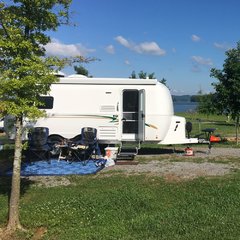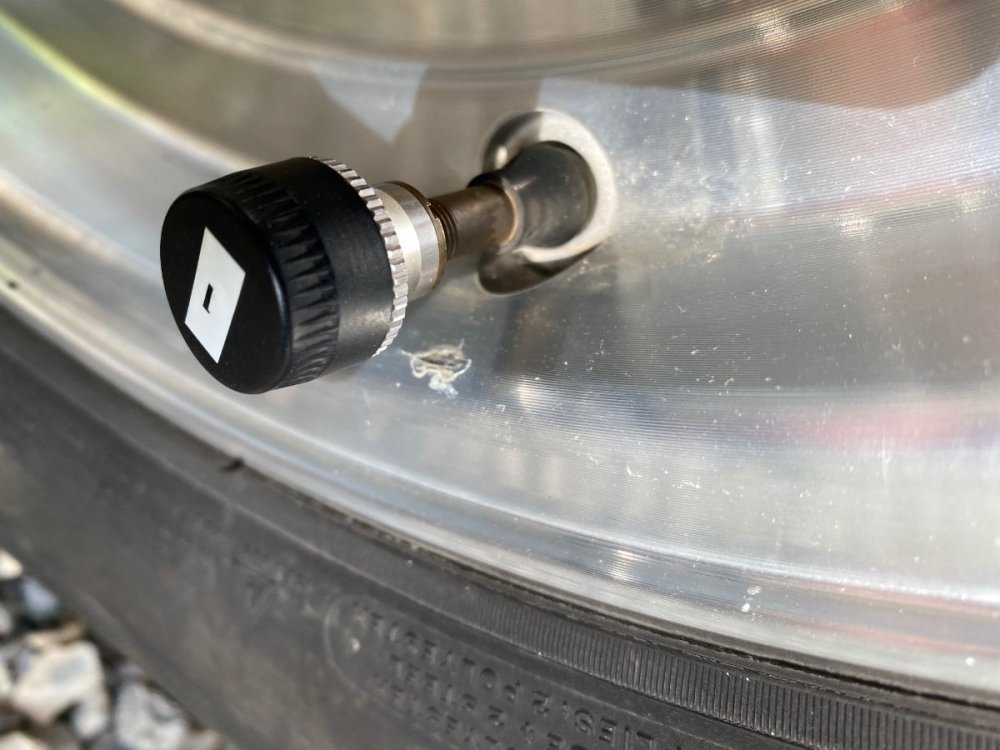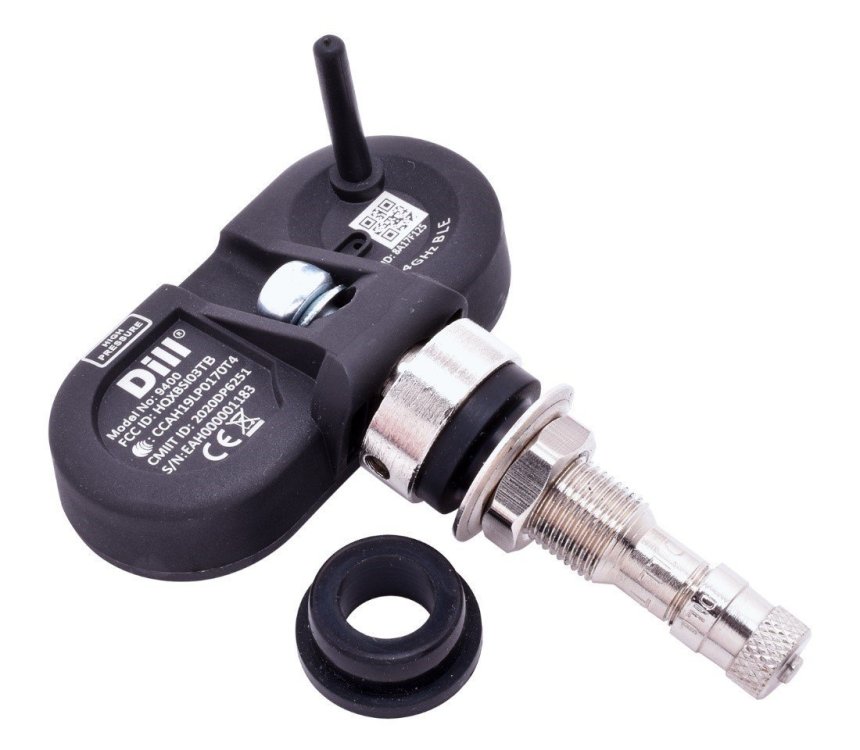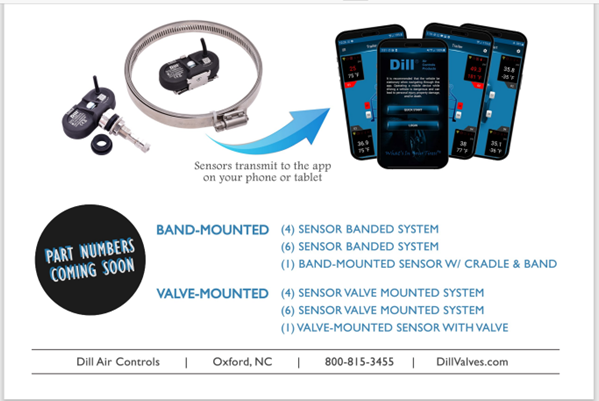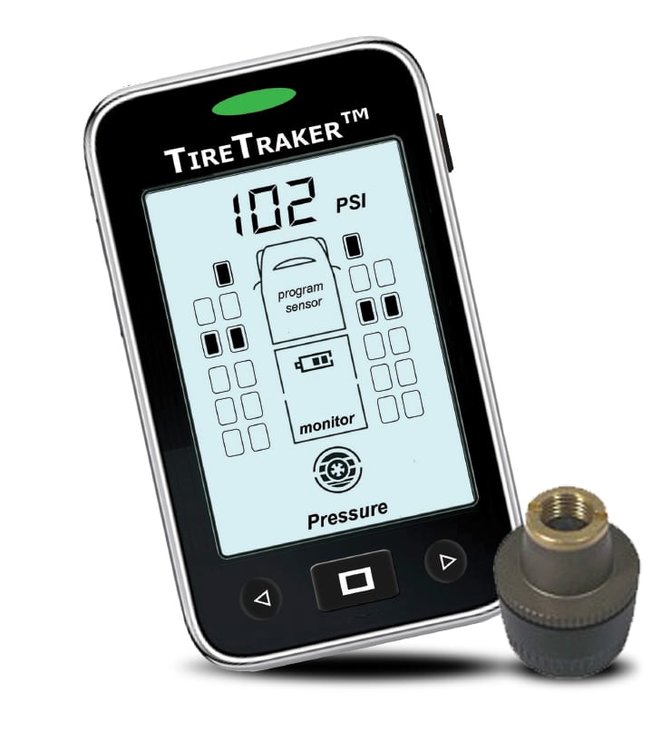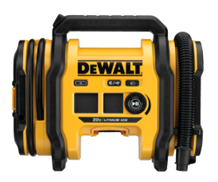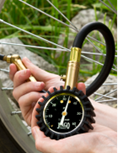Search the Community
Showing results for 'tpms'.
-
@johnwen, glad to hear your experience ended without injury or serious damage. We also installed a standalone TPMS for our LEII (Hull 990), the TireMinder i10, with 6 transmitters (TPMS), four for the trailer and the other two for our spares. See: https://technorv.com/products/tireminder-i10-rv-tpms-with-4-to-10-sensors?_pos=1&_sid=585f6a851&_ss=r I installed the signal booster under the dinette rear seat. I have tested the range by walking over 300 feet from the trailer with the monitor, without loss of signal. Our TV does not have the option for adding trailer sensors. Don
-
I assume from your post that other than the wheel rim there was no damage to the Oliver - wheel well, tire fairing, brake lines, brake wires, etc.? If that be the case then consider yourself to be very fortunate. Certainly there is a margin of safety in having two axles versus only one. And, a big thanks to that driver who alerted you to the problem. When purchasing my 2023 F-150 I too considered getting Ford's trailer TPMS. But even though it would be nice not to have yet another of these screens in the cockpit of the truck, the price was much higher than simply getting a stand alone TPMS. Also, I've found that having the stand alone TPMS I tend to monitor it more often. There are numerous brands on the market that do a great job of monitoring both pressure and temperature for the trailer and the spare tires on the truck and Oliver. I simply went to YouTube and Amazon, looked at features, size, reviews and price to get the one I liked best. Glad that you are OK. Bill
-
Our Oliver Elite 2 #1125 was one of the 25 or so units that had balance beads in the tires from the factory. My understanding is that the wheel/tire combos arrived at the mother ship already mounted and with the balance beads installed, a fact that was unknown to Oliver at the time. Once this fact became know to OTT, they mitigated the problem by sending out a set of 5 valves that have a sort of filter screen to prevent the balance beads from plugging up the valve mechanism which would result in the valve being held open and lead to loss of tire pressure. OTT also provided a visa debit card loaded with $25 to cover the cost of a tire servicer to replace the valves. We did the replacement last year and assumed all would be fine. The trailer has been sitting for about 2 months, a couple of weeks ago when I was prepping it for a voyage I discovered the TPMS was not functioning due to the batteries in the sending units having gone bad so I pulled out my trusty tire gauge and set out to check my tire pressures, only to find that when I removed the TPMS (caps) that the air was flowing freely out the valve stem, exactly as it had been doing before installing the "filter" valves meant to solve this problem. I immediately replaced the cap to prevent any further pressure loss, kicking the tires to determine if they seemed inflated enough for the 60 mile journey to the tire shop, which they were. Discount Tire in Montrose, Colorado was prompt to break down the tires, including the spare, thoroughly clean out the balance beads, replace all the valves, balance the tires the normal way (without balance beads) and remount the tires on the trailer, took about 60 minutes and they had 4 techs working on it at the same time. When I went to pay the bill the service manager smiled and said, 'Don't worry about it, just come to see us the next time you need tires." I told him that they had nothing to do with the balance beads installation, he acknowledged that fact but held his ground and refused payment. What a wonderful experience. To any of you who have had to deal with the Balance Bead issue, the solution of the filter valves is inadequate, the tires need to be remove from the rims and the Balance Beads physically cleaned out...Be Aware!!
-
I had DT install metal valve stems on all wheels last summer on a return trip from West Texas, had two rubber stem failures (with mounted TPMS devices) likely due to extreme heat at the time (110°+). Upon leaving, I went directly to a nearby Walmart and deflated the tires to 55 psi. That would be my guess.
-
I’ve never had any odd temperature readings on any of the four tires on my TST TPMS. I’ll be checking wheel temperature now too….
-
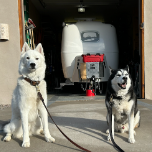
Tampa RV Supershow 2024, January 17 - 21
MAX Burner replied to SeaDawg's topic in General Discussion
Concur, 100%, @Mike and Carol. We actually bought our first TPMS at the RV Show here in '09! -
I have the TireTraker TPMS with the external sensors that thread onto the valve stem in place of the normal valve caps. While doing my spring cleaning on the Ollie, I noticed that all 4 aluminum rims have a wear mark on the rim directly adjacent to the valve stem (see picture). In researching this a bit, I found some comments on other forums about the weight of the external TPMS sensor causing the valve stem to deflect when the tire is rotating at highway speeds, and in some cases even causing the valve stem to fail. Anyone else observed this? Has anyone ever experienced a rubber valve stem failure while using the external sensors?
-
In looking at TPMS for the trailer that we are getting in November, I like the TST 507 tpms. It gives both tire pressure and temperature of the trailer tires and an audible warning when limits are exceeded. My vehicle has a tpms which lights up when the pressure is low. I like the idea of monitoring all tires (8) on truck and trailer. Is that overkill? Do you all just monitor the trailer and rely on the vehicle system for pressure only? Thanks in advance for your suggestions.
-

When to replace 2019 Elite II tires?
bugeyedriver replied to ScentFreeInSC's topic in Towing an Oliver
Topgun2 referred to the "date code" on each tire. Each tire will have a 4 digit number you can find on the sidewall. The first two numbers will be the week of the year and the last two will be the year. So, a "3222" code will tell you the tire was manufactured in the 32nd week of 2022. LT tires may show wear on the treads to indicate degradation, but ST tires treads can appear robust even after many, many miles, hiding the fact that they are "tired" and worn out. Failure to maintain proper inflation and loading within limits are the things that risk failure. An under inflated tire will result in excessive flexing of the sidewall as it rotates down to the bottom and bulges before swinging around the rest of the revolution. This repetitive motion may cause internal friction in the sidewall and overheating, leading to failure. Using a Tire Pressure Monitoring System (TPMS) is a great way to avoid this. The Wonder Egg gets new shoes whenever they are 6 years old. -
John, I will weigh in here - Per the TST tech I spoke with you will require the booster for TST to honor your warranty and for the TPMS to operate at its maximum potential. It takes a few min to connect the repeater. The TST tech also told me that using the system without the repeater you could easily have RF interference and you can easily loose your signal. My TST monitor is always on while plugged in and charging. When I unplug it from charging, it will shut off via the switch. I highly recommend you consider installing the booster/repeater for a proper install. 3 years in and my TST TPMS is working great. I do monitor my tires when traveling for heat and tire pressure. The monitor is so easy to read right there on my dash eye level. Cheers & Safe Travels from SW Colorado! Patriot🇺🇸
-

Best Tire and Wheel Sizes on your HD Tow Vehicles?
jd1923 replied to jd1923's topic in Towing an Oliver
Holding up on my tire purchase since I want to purchase a TPMS to install in the new truck wheels and our Oliver. I sure have enough other work to do, with the Oliver, let alone the truck and any travel plans will be in the new year. I read some posts here that mentioned Dill TPMS. Did some research and contacted them. They are releasing a new product this October, that seems worth waiting for! What a great reply I received from Dill Customer Service. Here's what Scott said, "Our new system is arriving in October. TireRack.com will likely be the first distributor with parts ready the ship. Please see the attached teaser flyer and User’s Guide. For your truck and trailer you would buy two of P# 1604-V. That gets you eight valve-mounted sensors and eight stems that would be compatible with 0.453” and 0.625” valve holes." You just buy 4, 6 or 8 stems with sensors attached and connect by Bluetooth, and then see your tire pressures on your phone. How great is that? No wiring installation! No proprietary screen on your dash! Can't wait! This is all falling together nicely- Gotta love it! -
“HOW OFTEN IS A SENSOR TRANSMITTING INFORMATION? This varies among manufacturers, but generally, sensors have different settings while parked and while in motion. The better question is what causes the sensor to transmit? When a sudden change in pressure is detected, the sensor should transmit whether the sensor is stationary or moving. When the tire starts to roll, tiny accelerometers cause the sensor to wake up and start broadcasting at regular intervals. In rolling mode, sensors transmit, on average, once every 30-120 seconds. While parked or in stationary mode, depending on the manufacturer, sensors may transmit only when a significant pressure change is detected. If a TPMS sensor transmitted all the time, a sensor would not last very long. Most TPMS sensors will transmit when movement is detected through a simple accelerometer inside. If the wheel stops moving, the sensor will stop broadcasting after a programmed amount of time. But once it is triggered, the sensor transmits on a predetermined interval set by the manufacturer. A sensor will immediately send a signal if it detects a sudden loss in pressure.” https://www.underhoodservice.com/tpms-radio-frequency-theory-and-operation/ Mine has screw on sensors, and when getting ready to leave in the morning I “wake up” each one with a couple of raps from my finger so they transmit today’s value, not the one from when I arrived, in case one of the tires picked up a nail and was quietly deflating overnight. I would much prefer to see that warning or low pressure reading in the campground than a couple of miles down a busy highway… and this is a great reason to NOT choose a type that installs inside the tire. You can’t wake those up except by driving away. John Davies Spokane WA
- 1 reply
-
- 4
-

-
We had almost the exact same encounter with a blowout about 12 years ago in FL traveling on a secondary road at about 45mph. At the time we didn't own a standalone TPMS. We didn't realize the right side rear tire blew until we pulled over at a convenience store for a pee - walking back to the rig we saw what looked like a "ghost tire" (formerly a Goodyear Marathon) with only the radial material left on the rim. With a TPMS (which we've had ever since), at least would have known when it blew and proceeded accordingly rather than driving for an unknown distance on 3 good wheels/tires. Glad no injuries ensued....
-
I got the EZZ Tire TPMS a few years ago and have been satisfied. Batteries are easy to change too. As rich.dev says - ANY TPMS is better than nothing! Whatever you do - get a TPMS with 6 sensors. You will need 4 sensors for the Ollie tires hitting the ground plus a 5th sensor for the spare tire. The 6th sensor is for the spare tire on your tow vehicle. Bill EEZ Tire can be found HERE.
-

TPMS Sensors Stuck on the Valve Stems
topgun2 replied to Carl Hansen's topic in Mechanical & Technical Tips
Carl - Another thing that you can try is to press down (towards the tire) on the TPMS while at the same time turning the TPMS anti-clockwise (lefty loosey). If the sensors aren't on too tight this just might work without that little wrench. One more - Hold the main body of your TPMS in your left hand and use your right hand to try to twist the very top of the TPMS (again anti-clockwise). Again, if the top isn't screwed on too tight, it just might come off without that little wrench. And, finally - if you have either a thin head adjustable wrench or a thin pair of pliers, you can use those in place of the little wrench. Be a bit careful doing this in that you certainly do not want to bugger up the relatively soft plastic that these TPMS housings are made out of. Bill -
I had a unique opportunity on a recent trip we took while towing our Ollie down to the Chesapeake Bay for a little vacation. Actually observed a trailer tire failure in real time. Driving in moderately heavy traffic on an interstate at 60-65 mph, we were a bit behind a pickup truck towing an SOB dual axle travel trailer. It was a section of the interstate with 3 lanes in each direction. I was in the far right lane as usual, and the pickup truck/TT ahead of us were in the center lane. My wife and I both noticed that the forward tire on passenger side of the trailer ahead of us was low and the sidewall of the tire was oscillating side to side noticeably. Our position to the rear and right of the other trailer gave us a great viewpoint. The oscillations were getting worse, but the pickup truck driver was showing no indication he noticed anything at all as he happily maintained his speed. I tried to speed up an little to get alongside to try to honk/wave to warn him, but traffic opened up a bit at that point and he actually sped up significantly, so I fell pretty far behind. At this point, small chunks of rubber were now being thrown off the tire, but the driver continued on at speed. I gave up on my attempt to get alongside to warn him since I didn't feel safe getting closer, and actually backed off a bit further. Within another 30 seconds larger chunks of tire started coming off, followed by pieces of aluminum siding from the trailer side wall around the wheel well as the entire tread started coming off the tire and whipping around in the wheel well. So I slowed down even more to get a very safe distance behind from the impending disaster. Incredibly, the driver was still maintaining his speed! Probably doing 70mph and in the middle lane of three lanes of traffic! The full tire tread soon came off, fortunately I was far enough behind to avoid it easily along with all the other debris laying in the road at this point. By now other drivers closer to him in traffic were honking & waving at him, and he probably felt some drag or vibration at this point, and he finally figured out something was wrong, but because he was in the middle lane of the three lanes, and with the traffic, it took him quite a bit of distance to finally get over to the far right lane and he exited at an off ramp and pulled off on the shoulder there. By that point the tire was completely gone, but fortunately since it was a dual axle trailer, the driver never lost control. Some lessons learned, and/or reinforced. A very strong reminder of the need for a good TPMS system (I've had one since day one with our Ollie Elite II). A great demonstration of the advantage of a dual axle trailer for stability. And also a reminder that keeping to a reasonable speed and staying in the right hand lane most of the time are good practice.
-
I started this as a PM to GeronimoJohn and it got so wordy, I decided to post it here. I researched these systems a long time and decided on the Tire Traker. They have stellar customer service and are sometimes at (really) big RV shows and places like Quartzite. The sensor batteries are to be replaced annually, but may last longer - they use cheap button cells. I bought a repeater in case the distance was too far but have NOT needed it. I suggest that you buy the four sensor set, an extra sensor for the spare tire, and the maintenance package. The only thing I did not like was that the trim on the perimeter of the display is bright and it reflected sunlight in the windshield. I painted the upper part on mine flat black. Some electrical tape would also work. The display is rechargeable and runs up to a month, and in sleep mode it wakes up when there is a signal from the wheel sensors. They too wake up when moving, to save the batteries. I try to remember to shut my display off every evening. The mount is a suction cup and very nice. There is no case for the display; I use a soft cloth drawstring bag from a set of sport goggles for storage. The system shows individual tire pressures and temperatures. There are preset alarm levels for both. If you get a slow leak, the alarm will come on at a reduced level to let you know that you need to pull over. By watching the display you can tell if it is slow or a big one. If it is a big leak the alarm is more intense. The sensor on the spare tire lets you know that it has not gone flat, since it is a small PITA to check. If one of the main sensors fails, you can swap the spare onto that wheel until you can get a replacement. Or just order an extra sensor now... The temperature display is useful since it shows the temps increasing as the tires heat up during towing, which is completely NORMAL, and if there is one that is abnormally warm, you can stop and see if there is a brake or bearing issue on the hub. NOTE: because the sensors are spinning in ambient air on the end of the valve stems, I doubt that the displayed temps are especially accurate. A sensor inside the wheel would be a much more reliable and accurate system. I honestly don't see how the external sensors could read inside temps, but they do to a certain degree (pun intended). I don't think that the display dims, I have never used it at night. I suspect you would want to take it off the windshield and just set it in a low cupholder. It would still alarm if needed. If somebody knows if the lighting dims, please comment. The system gets very good reviews, you can get from Amazon, but I ordered direct from Tire Traker. Setup: Charge the display several hours. After first checking and adjusting your COLD tire pressures (I use 60 psi), it will take you about ten minutes to set it up, there are many videos showing how. You have to set the alarm threshold (enter the cold tire pressure), install batteries into sensors and put them on the wheels one at a time. As each one "wakes up" it will show up on the display and you can adjust its position of the vehicle diagram, for example "left rear" on the trailer drawing. Position of the display: I mount mine at the lower left corner of the windshield. It is easy to see, but neither in my direct line of sight, nor close to my Garmin gps. Aftermarket devices like a gps that use radio signals may possibly cause interference. My RV 660 is mounted along the center of the windshield and I have noted no interference when using my Garmin remote (trailer backup) camera. If you have trouble with the TT-500 signal, you may need to mount their booster inside the trailer connected to an always-on power source. If you have the factory backup camera, the area behind the switch would be a great location, and you can use the switch to power on the booster when you switch on the camera. https://www.tiretraker.com/proddetail.php?prod=TT500-4 https://www.tiretraker.com/proddetail.php?prod=TT50 https://www.tiretraker.com/proddetail.php?prod=TT-MAINT Installation video: If you are driving an older tow vehicle without its own TPMS, you can order extra sensors and use the Tire Traker to monitor those tires also. This system is versatile and mine has been reliable for a year. It gives great peace of mind when towing, especially in inclement weather and in remote areas, which is priceless. Anything you can do to reduce your anxiety level while towing is a good thing. HIGHLY recommended! I towed trailers for 45 years without TPMS, and I am very glad I invested in this. John Davies Spokane WA
-
Question - has anyone determined if the TPMS temperature measurement will track (albeit delayed) bearing heating due to bearing wear and impending failure? I like the hub caps and use bearing buddies along with periodic bearing repacking to minimize the chance of bearing failure. And yes, the bearings were replaced with genuine Timken's before our Alaska adventure.
-

TPMS Sensors Stuck on the Valve Stems
Rivernerd replied to Carl Hansen's topic in Mechanical & Technical Tips
My Tire Minder TPMS sensors come with a nut that is tightened by the little wrench. If you try to unscrew the TPMS sensors without first loosening the nut with the little wrench and then spinning the nut toward the wheel, the TPMS sensors will not budge. This is a theft-deterrent measure--Tire Minder figures a casual thief won't have one of the little wrenches, but you will keep the one they supplied. If yours are Tire Minders, try loosening the nut first, then spinning it toward the wheel. A Tire Minder TPMS sensor will then twist off with just counterclockwise hand pressure. -
Four thoughts: A. Topgun2's statement is spot on. There is not much we can do about the heat in our tires except changing our driving habits as the road surface varies. That said, there are a substantial number of blowouts due to heat related to under-inflation causing sidewall flex and that causing blowouts. So, general consensus is that within the tire pressure range, it is better to be a bit high than lower. B. Knowing the impact of your trailer and all loads in and on the TV is important. Get this by weighing your TV and trailer, each fully loaded. Also weigh your TV with just normal day to day loads. With these numbers, check the tire pressure guide from your tire MFG. Adjust accordingly. And keep Thought "A" in mind. C. It took me a long time to understand how much tire pressure changes between "Cold" and hot conditions. I often thought I had a slow leak or a bad air pressure gauge during morning checks. So I recommend checking tire pressure early in the morning while the sun has not yet had much of a chance to mess with the tires. Once you have set them, don't worry about them during the heat of the day. As a young man while towing across Texas, I checked them at the gas station in El Paseo in 105 degrees. I made that mistake of lowering the TP to "Cold" pressure. The result was two blown trailer tires about 90 miles from nowhere. Sidewall flex heat generated from under inflation.... Once again, see Thought "A" above. D. Get a TPMS for your trailer and TV. They can give you advance warning that can easily warn of a slow leak or underinflation before it becomes a mess. I highly recommend the below air compressor and tire pressure gauge. I also use the below TPMS and have had good service. It however is a bear to program and reprogram. I bought my TPMS in 2018. Hopefully by now there are more user friendly ones. So, I recommend looking to the OTT Forum for more current TPMS recommendations. Bottom line is for this topic, for sure buy quality. ESSENTIAL TIRE MAINTENANCE TOOLS Dewalt 20V Air Compressor TPMS JACO Air Pressure Gauge NOTE: Every Jaco product is designed, manufactured, and supported in the U.S.A. Jaco has been manufacturing in Franklin Massachusetts for more than 45 years. Their tire pressure gauge is calibrated accurate to ANSI B40.1 standards.
-
Just curious did a search in this forum to no avail. Anyone use a TPMS on their Olie? Thinking on the TST system, Thoughts? Pat
-
Anyone running with this one? I want a TPMS for pickup but like having and app versus another device on the dash as main source of info and warnings. Where and how have folks wired in the amplifier for signal? TIA
-
I'm wondering if any Oliver owners use a TPMS for monitoring all the tires while on the road?
-
I second the TST tpms, but any tpms is better than nothing!
-
Our previous SOB TT had a TPMS with sensors that required shipping back to the factory for battery replacement (2003 vintage). Not a cheap date!. After going through that drill a couple times, we opted for a new style TPMS that comes with its own battery replacement tool kit, spare O-rings, and valve stem-mounted dust caps. Its a cool set-up, albeit a bit of a small read-out screen, but its solar powered - so far, so good.





